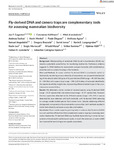Fly-derived DNA and camera traps are complementary tools for assessing mammalian biodiversity
Gogarten, Jan F.
Hoffmann, Constanze
Arandjelovic, Mimi
Sachse, Andreas
Merkel, Kevin
Dieguez, Paula
Agbor, Anthony
Angedakin, Samuel
Brazzola, Gregory
Jones, Sorrel
Langergraber, Kevin E.
Lee, Kevin
Marrocoli, Sergio
Murai, Mizuki
Sommer, Volker
Kühl, Hjalmar
Leendertz, Fabian H.
Calvignac-Spencer, Sèbastien
Background
Metabarcoding of vertebrate DNA found in invertebrates (iDNA) represents a potentially powerful tool for monitoring biodiversity. Preliminary evidence suggests fly iDNA biodiversity assessments compare favorably with established approaches such
as camera trapping or line transects.
Aims and Methods
To assess whether fly-derived iDNA is consistently useful for biodiversity monitoring across a diversity of ecosystems, we compared metabarcoding of the mitochondrial 16S gene of fly pool-derived iDNA (range = 49–105 flies/site, N = 784 flies) with camera traps (range = 198–1,654 videos of mammals identified to the species level/site) at eight sites, representing different habitat types in five countries across
tropical Africa.
Results
We detected a similar number of mammal species using fly-derived iDNA (range = 8–15 species/site) and camera traps (range = 8–27 species/site). However, the two approaches detected mostly different species (range = 6%–43% of species detected/site were detected with both methods), with fly-derived iDNA detecting on average smaller-bodied species than camera traps. Despite addressing different phylogenetic components of local mammalian communities, both methods resulted in similar beta-diversity estimates across sites and habitats.
Conclusion
These results support a growing body of evidence that fly-derived iDNA is a cost- and time-efficient tool that complements camera trapping in assessing mammalian biodiversity. Fly-derived iDNA may facilitate biomonitoring in terrestrial ecosystems at broad spatial and temporal scales, in much the same way as water eDNA has improved biomonitoring across aquatic ecosystems.
Files in this item

